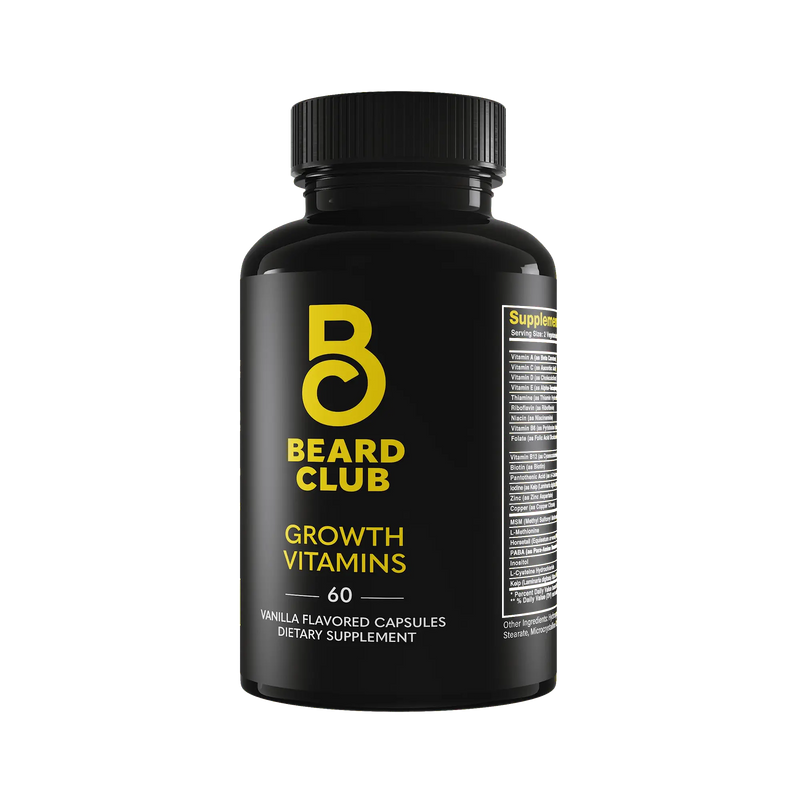How To Grow a Thicker Mustache With These 5 Pro Techniques
Patchy facial hair can be a challenge, especially since your unchangeable genetics are the prime influencer of how much hair you grow on your face. Dealing with patches in your facial hair is especially difficult when there is a particular beard or mustache style you're going for. We understand the struggle.
While genetics mainly determine how your facial hair naturally grows, some techniques might give you the growth you've been waiting for.
Factors like age, diet, and stress can all impact the thickness of your mustache. Luckily, we're here to help you work against these challenges. This guide gives you all the information you'll need to thicken your 'stache.
All we ask is that before you shave the stache, you give that mustache a fair chance and do everything you can to make it work. It'll be worth it!
From patience to supplements to tools and styles, we researched and compiled everything you need to know to get your mustache looking thicker. Just like it takes a village to raise a child, it also takes a club to grow a mustache. Every person is different, so if one technique fails, simply try the next one!
1. Patience
You probably already know that patience is key, but maybe you're not putting that saying into practice. Perhaps you've waited weeks or even a month for your whiskers to come in fully. That's a long time and somehow slower than watching grass grow. However, facial hair can, unfortunately, take up to four months to come in fully.
Yup, if you thought one month was long, try quadrupling it! Even after four months, there is no guarantee you'll have the mustache of your dreams, but you can only be sure once you see it all the way through. So, put that razor away and mark your calendar. You're in for the long haul — but it's worth it.
The good thing is that you won't just be sitting around. You can do all the following steps in the waiting; in fact, some of them are important to incorporate into your everyday grooming routine.
2. Beard Balm, Growth Oil, Vitamins, and Vitamin Spray
Did you know your beard is kind of like grass (in a way)? It needs nutrients, water, strong roots, and upkeep. Furthermore, it can also take forever to grow sometimes, but once it comes in thick, it looks awesome.
Beard oil and balm are standard products you should already have at your disposal if you ever do anything at all with your facial hair besides shaving it off. Even then, these products are fantastic for your hair follicles. They provide plenty of natural oils to replace the ones lost whenever you wash your face or beard.
If you want your mustache to come in thick, you need to supplement your standard beard oil with Beard Growth Oil. While the names are similar, the beard growth oil is chock-full of ingredients that help stimulate facial hair growth. As your hair follicles soak in these ingredients, they will gain the nutrients they need to thrive.
In addition to applying this oil, try taking Beard Growth Vitamins. While the oil nourishes your mustache from the outside, the vitamins help give your body the nutrients needed to nourish your mustache from the inside. Vitamins A, B, C, D, and E are all included.
Last but not least is Beard Growth Vitamin Spray. This spray includes essentials such as biotin, peppermint, and glycerin, as well as several other ingredients. These will help enhance and moisturize that fledgling 'stache.
3. Mustache Styling
Styling is everything when it comes to a mustache. When that upper lip hair is all alone on your face, it has to be intentionally styled for people to notice it. This step is probably one of the most fun, though, since you get to try all kinds of mustache styles.
You don't need a handlebar or Chevron mustache to make a strong first impression. There are other styles, such as the pencil mustache, that don't need much thickness at all. Another option is to see where your mustache grows in the thickest and work with what you have.
The way you style your mustache is much more important than its thickness. You can always make it look at least slightly thicker than it is with some styling tricks.
4. Helpful Tools
Every professional knows that if you want to get the job done, then you need the right tools.
This is just as true for grooming your facial hair. Using whatever you have on hand is not going to cut it. If you treat your mustache right, it will return the favor. Mustache maintenance can help stimulate its growth and cause it to look thicker if done properly.
Trimmer
Keeping your mustache uniform is crucial. If stray hairs begin to grow out past the line-up, then it will make the rest of the mustache look small and thin. A decent beard trimmer can keep all the wild hairs in line as you continue styling them and growing them out.
A trimmer that has several settings and various heads and guards to choose from is ideal — our recommendation is the PT45 Beard and Hair Trimmer. This way, you'll always have options in case you decide to change up your style at any point.
Scissors
A good pair of beard-trimming scissors or mustache scissors can make all the difference. Beards are fickle animals and need the utmost precision. Even "lazy looks" and scruff need to be meticulously manicured to keep up appearances.
Don't merely grab the first pair of crafting scissors you can find. Most of the time, the scissors that you find around the house are dull and will damage your stray facial hair strands rather than slice them with precision. Invest in some Beard Trimming Scissors to handle this task.
Beard Roller
Beard rollers, also known as Derma rollers, are very popular in the beard world these days because of their innovative approach to facial hair grooming. This roller features micro needles all over its cylindrical surface and pierces the top layer of skin, stimulating blood flow and increasing the production of collagen. This, in turn, helps with facial hair growth.
Mustache Wax
This final tool is strictly for styling and is the best way to get your mustache to go in the direction you want. While wax does not directly affect growth, it does help your mustache to appear thicker since it brings the individual hairs closer together and coats them with wax. The main ingredients in our Beard & Mustache Wax are beeswax and shea butter, which help give your beard a soft feel and sleek look.
5. Should You Dye Your Mustache?
This particular method is last on our list because it only works for a select portion of the population. For those men whose mustache hair is blonde or light brown or a color lighter than their hair, there's always the option of dying.
Many men have a mix of blonde hairs intermingling with their stache, presenting an excellent opportunity to take some beard dye and turn those blonde hairs darker. This idea is only a temporary fix, of course, but it can at least provide a thicker appearance while you wait for more hairs to grow in.
Dyeing a mustache can be a whole style choice in itself. Don't be afraid to experiment and dye it a different color than your hair. Many men naturally have red beards with brown or blonde hair, so mixing colors won't look unnatural if done right.
The ‘Stache Is King
Spare yourself the effort of trying to figure this all out on your own, and take our advice laid out above. This is a community for men just like you, so reach out and ask questions! We have everything you could ever want and more for your facial hair here at The Beard Club.
Your mustache is a part of your body as much as your hands, feet, ears, and toes, so treat it like you would the rest of yourself. Your 'stache needs meticulous care and consistent, routine grooming if you want any chance at rocking the thick mustache you've always wanted. Invest in something important to you: It's worth it.
If you try everything above and still come up short, then there are more drastic measures that can be taken. Hair implants are the most common example of a major treatment for a patchy mustache.
However, you should discuss that option with your doctor or a specialist. Don't be afraid to change things up and rock your natural look. You have every reason to be proud of the facial hair your genetics gave you.
Sources:
Can't Grow a Full Beard? There's an Explanation for That | Cleveland Clinic
Movember: How to Sport Your New 'Stache | Genesis College
Here's why some people have red beards, but brown hair on their heads | Business Insider India


















